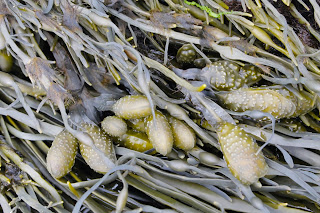It was a Facebook ad I clicked on that lead me here, with promises of whales, tidal pools, and magnifying lenses. I was going to a foreign country to look at periwinkles and plankton!
One of my favorite wildflowers is goldenrod. Contrary to popular belief, it's not goldenrod that causes allergies, but ragweed, in bloom around the same time. Ragweed is wind-pollinated, so pollen is air-borne. Goldenrod is insect-pollinated, so pollen is carried from plant to plant by insects such as the unique bumble bees I saw here. Below is the seaside or salt marsh goldenrod, adapted to salty, course soils. It would be the end of soil for a while...
We followed our guide Greg Turner (info@GaelTours.ca) further to the rocks below. We had learned about the basalt and volcanic rock across the bay when we visited Balancing Rock in Tiverton (Long Island), NS. Now we looked closer. The reddish-brown lines were red oxide, or iron rust. There appearance was caused by a chemical reaction. Over time, water and the red oxide could split boulders!
There was little to no soil here. We needed lichen and a few 100,000 years.
Sometimes air pockets formed as the rocks cooled, leaving behind pock-mocks.
But the site was far from barren...
An
inuksuk greets us atop of a formation further on. Take nothing and leave nothing is the golden rule, but this marker made out of stones at hand tells that people were here, and perhaps trails or food are ahead.
The tide had receded, yet some water remains. It feels like we're on an alien planet. What life is out there?
A beach plantain has found a tiny nook of soil between rocks.
Some of the water looks brown. Is it the red oxide, or the lichen on the rocks?
We find a tidal pool, more like a tidal puddle, full of floating life.
We look at the seaweed's cell structure with round lenses we can hold over the water. But our guide tells us to look for the even tinier...
Those black spots are creatures: Amphipods and more! We don't have the magnification for plankton.
We examine other puddles, getting closer to the source of water.
What's this? Periwinkles! They are harvested as food by some.
We examine more red in the rocks and our first seaweeds. These have air-filled bulges that help them float.
Periwinkles, seaweed, more amphipods...
A male crab hunting for tasty creatures!
We look in further. Would we find the origins of our own species?
Further past the primordial ooze are a diverse array of seaweeds. Peeling them back feels like we are the microscopic ones on a dog's back, looking for our friends amidst the fur.
And we find them!
We have now found three species of periwinkle.
And quite a few species of seaweed!
They look like tiny pickles!
Or chicken feet.
Actually, many of the seaweeds are edible. We tried seaweed chips our guide had brought. If you like kale chips, you'll love these! Nova Scotians and Mainers also dry a blend of seaweeds as a seasoning called
dulse. Very yummy. We got to see nori, which is used in making sushi rolls, and sea lettuce, which is delicious all by itself.
Next, we tapped into the source: A finely-netted basket was pulled through the sea water.
In that water were more amphipods, very active in our examining cup!
Here's a less common white periwinkle that was hiding beneath the seaweed.
The seaweed-looking creature below is actually the skeletalized remains of a bryozoan colony (
Flustra foliace), which when you rub it smells like lemon! Fishermen call it "lemon weed". It is eaten by sea urchins and nudibranchs (sea slugs). Other creatures such as sessile worms, the porcelain crab, even other Bryozoa can live on it as a substrate. A colony might live for 12 years.
An interesting find:
Native scallop:
Can you guess what's on the right?
Here's the other side...
It's the smallest bone in the body. An inner ear bone. Of a humpback whale.
Here's a humpback whale from our Whale Watch in the Bay of Fundy:
Humpbacks do not have teeth, but baleen, which they use to sieve out hundreds of pounds of tiny plankton. They'll chase the plankton into dense, huddled balls, then swallow them all up. In an ecosystem, even the tiniest creature can have huge impacts on others higher on the food chain. What affects the plankton (such as algal blooms mostly caused by fertilizer run-off or incompletely treated sewer water) can affect the many creatures that are part of its food web, including us.
Thank you Greg Turner and Gael Tours for all we learned about the tiny creatures of the tide pools, as well as helping us arrange a whale watch and trail walk across the bay. The Bay of Fundy has the highest tides in the world. We had explored the rocks and tide pools while the tide was low. Looking back, water already covered where we had been...

























































































































